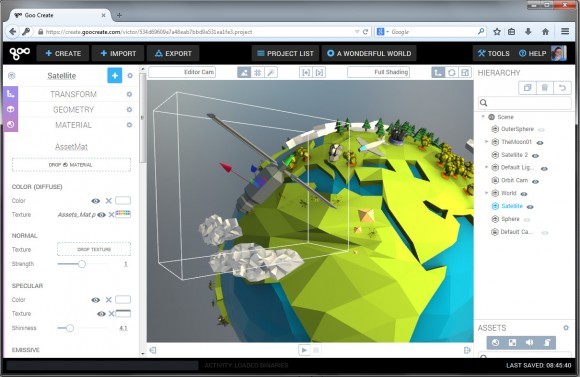
The in-browser 3D technology WebGL is one of those technologies that got the world excited a few years ago but since then hasn’t been making many headlines. Looking at the Google Trends graph below, the world got excited about the promise of the technology in 2011 when Chrome, Mozilla, Opera and others first decided to integrate the tech into their browsers. But after the initial buzz surrounding the technology, the tools needed a little bit of time to catch up to the hype.
The applications of WebGL are pretty amazing, however. Looking at these links where you can row a rowboat through pretty intense graphics, right in your browser, you can see we’re barely scratching the surface of WebGL in day-to-day internet life.
“It’s been very much of a demo scene,” says Ola de Freitas, CEO of Stockholm-based Goo Technologies. ” At chromeexperiments.com people are putting up demos, but bridging that gap from the demo scene to commercially, that’s where we are right now.”
What’s missing is the tools to build the next generation of interactivity for the web and the commercial demand to push things forward. This is where Stockholm-based Goo Technologies comes with their Goo Create platform that allows anyone to easily start creating 3D for the web, for free, right in their browser.
Like the rowboat link above, gaming was the first natural extension of WebGL. When first launching their platform Goo Technologies was focused on creating tools for the gaming sector but somewhat recently pivoted their business model to the next valuable location, the advertising sector, while still keeping gaming on board.
They’ve seen some success so far. Goo Technologies created what they’ve called the world’s first rich WebGL advertisement for Aftenbladet, the Swedish news tabloid, which as you can see in the video below.
The rushing 3D graphics are tough to ignore even for the most banner blind among us, which shows the benefits of using flashy 3D graphics in this type of location. But instead of being a next-generation Flash advertisement, the interactivity available in WebGL also provides a more rich advertising experience.
During the World Cup, Goo worked with Nike and Google on their Risk Everything campaign to provide fans tools to capture their favorite moments from Nike sponsored players. Immediately after a massive play, the team recreated the moment using Goo allowing fans to take their own camera-positioned shots of Dempsey going for a header, or Ronaldo going for a big kick, and then share those on social media.
“What Google and Nike were trying to do was an experience that doesn’t feel like an advertising campaign,” says de Freitas, who also pointed out long on-page statistics of people interacting with the brand.

Right now the company is in ecosystem creation mode – building up demand from advertisers while simultaneously moving to get their platform in the hands of creative agencies and studios.
For their revenue model, it’s free for one person to use and build on the platform, but if you want to start collaborating with a team, then they start charging per user. Additionally Goo is positioning themselves to host and serve these games and advertisements.
More and more sectors are starting to see how they can use the technology, anything from product visualizations of new cars or showing off apartment real-estate. With the launch of iOS 8, WebGL will be enabled by default, opening up more applications of the technology to a new type of audience, perhaps creating another spike of interest.
With an August 2013 seed round led by Rovio Chairman Kaj Hed’s MOOR Capital, de Freitas and his team of roughly 40 has room to grow.
“I was just talking to my co-founder CTO Rikard Herlitz about ‘look where we were a year back.’ We were knocking down doors … but now we’re getting new requests every week.”




